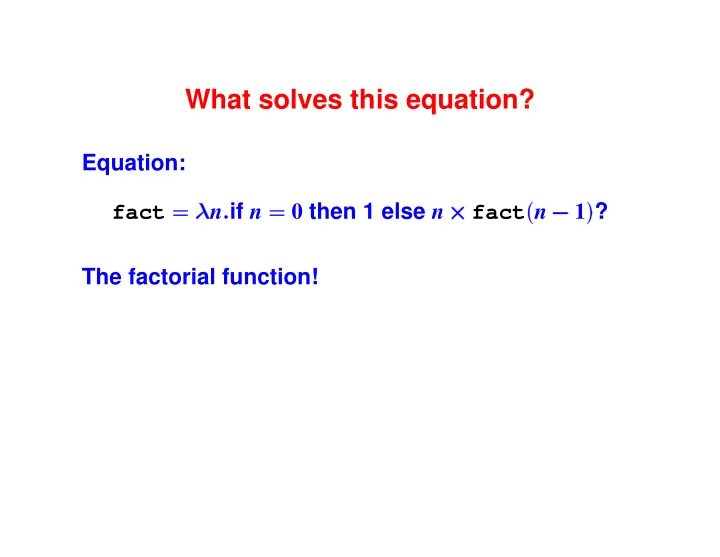

What solves this equation? Equation: � n : if n = 0 then 1 else n � 1 ) ? fact � fact ( n = The factorial function!
Factorial in lambda calculus Wish for: fact = \n.(zero? n) 1 (times n (fact (pred n))); But: on right-hand side, fact is not defined.
Successive approximations Function bot always goes into an infinite loop. What are these? fact0 = \n.(zero? n) 1 (times n (bot (pred n))); fact1 = \n.(zero? n) 1 (times n (fact0 (pred n))); fact2 = \n.(zero? n) 1 (times n (fact1 (pred n)));
Successive approximations (manufactured) g = \f.\n.(zero? n) 1 (times n (f (pred n))); fact0 = g bot; fact1 = g fact0; // = g (g bot) fact2 = g fact1; // = g (g (g bot)) fact3 = g fact2; // = g (g (g (g bot))) ...
Fixed point Suppose f = g f. I claim f n is n factorial! Proof by induction on n.
Fixed-point combinator What if fix g = g (fix g) Then fix g n is n factorial! fix g = g (fix g) = g (g (fix g)) = g (g (g (fix g))) = ... Expand as much as you need to.
Y combinator can implement fix Can define Y such that, for any g , Y g ( Y g ) . = g (Details next time, with evaluation model.)
Conversion to fixed point length = \xs.null? xs 0 (+ 1 (length (cdr xs))) lg = \lf.\xs.null? xs 0 (+ 1 (lf (cdr xs)))
Example recursion equations Is there a solution? Is it unique? If so, what is it? f1 = \n.\m.(eq? n m) n (plus n (f1 (succ n) m)); f2 = \n.f2 (isZero? n 100 (pred n)); f3 = \xs.xs nil (\z.\zs.cons 0 (f3 zs)); f4 = \xs.\ys.f4 ys xs;
Wait for it...
Example recursion equations f1 = \n.\m.(eq? n m) n (plus n (f1 (succ n) m)); ; sigma (sum from n to m) f2 = \n.f2 (isZero? n 100 (pred n)); ; no unique solution (any constant f2) f3 = \xs.xs nil (\z.\zs.cons 0 (f3 zs)); ; map (const 0) f4 = \xs.\ys. f4 xs ys; ; not unique: constant funs, commutative ops
Church Numerals Encoding natural numbers as lambda-terms zero � f :� x : x = one � f :� x : f x = two � f :� x : f ( f x ) = succ � n :� f :� x : f ( n f x ) = plus � n :� m : n succ m = times � n :� m : n ( plus m ) zero = Idea: “apply f to x , n times”
Church Numerals to machine integers ; uscheme or possibly uhaskell -> (val add1 ((curry +) 1)) -> (define to-int (n) ((n add1) 0)) -> (to-int three) 3 -> (to-int ((times three) four)) 12
Church Numerals in � zero = \f.\x.x; succ = \n.\f.\x.f (n f x); plus = \n.\m.n succ m; times = \n.\m.n (plus m) zero; ... -> four; \f.\x.f (f (f (f x))) -> three; \f.\x.f (f (f x)) -> times four three; \f.\x.f (f (f (f (f (f (f (f (f (f (f (f x)))))))))))
Recommend
More recommend